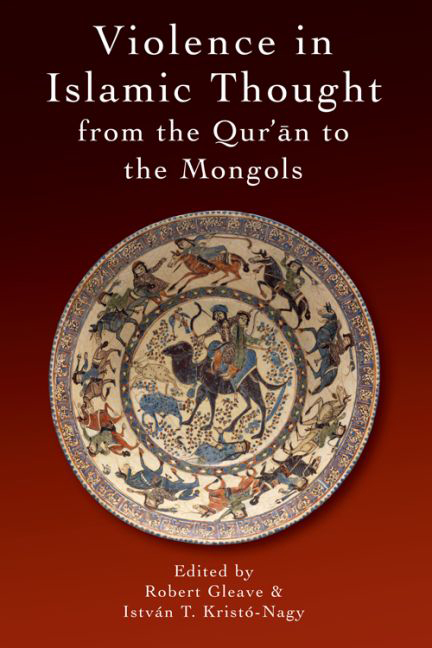Book contents
- Frontmatter
- Contents
- Dates and Abbreviations
- List of Figures and Tables
- 1 INTRODUCTION
- PART I JIHĀD AND CONQUEST: ATTITUDES TO VIOLENCE AGAINST THE EXTERNAL ENEMIES OF THE MUSLIM COMMUNITY
- PART II THE CHALLENGED ESTABLISHMENT: ATTITUDES TO VIOLENCE AGAINST THE STATE AND IN ITS DEFENCE WITHIN THE MUSLIM COMMUNITY
- PART III LUST AND FLESH: ATTITUDES TO VIOLENCE AGAINST THE DEFENCELESS, INTRA-COMMUNITARIAN VIOLENCE BY NON-STATE ACTORS
- 10 VIOLENCE AGAINST WOMEN IN ANDALUSI HISTORICAL SOURCES (THIRD/NINTH–SEVENTH/THIRTEENTH CENTURIES)
- 11 SEXUAL VIOLENCE IN VERSE: THE CASE OF JITHIN, AL-FARAZDAQ'S SISTER
- 12 BANDITS
- 13 EATING PEOPLE IS WRONG: SOME EYEWITNESS ACCOUNTS OF CANNIBALISM IN ARABIC SOURCES
- 14 ANIMALS WOULD FOLLOW SHĀFIISM: LEGITIMATE AND ILLEGITIMATE VIOLENCE TO ANIMALS IN MEDIEVAL ISLAMIC THOUGHT
- Bibliography
- Index of Qurānic Citations
- General Index
10 - VIOLENCE AGAINST WOMEN IN ANDALUSI HISTORICAL SOURCES (THIRD/NINTH–SEVENTH/THIRTEENTH CENTURIES)
from PART III - LUST AND FLESH: ATTITUDES TO VIOLENCE AGAINST THE DEFENCELESS, INTRA-COMMUNITARIAN VIOLENCE BY NON-STATE ACTORS
Published online by Cambridge University Press: 15 September 2017
- Frontmatter
- Contents
- Dates and Abbreviations
- List of Figures and Tables
- 1 INTRODUCTION
- PART I JIHĀD AND CONQUEST: ATTITUDES TO VIOLENCE AGAINST THE EXTERNAL ENEMIES OF THE MUSLIM COMMUNITY
- PART II THE CHALLENGED ESTABLISHMENT: ATTITUDES TO VIOLENCE AGAINST THE STATE AND IN ITS DEFENCE WITHIN THE MUSLIM COMMUNITY
- PART III LUST AND FLESH: ATTITUDES TO VIOLENCE AGAINST THE DEFENCELESS, INTRA-COMMUNITARIAN VIOLENCE BY NON-STATE ACTORS
- 10 VIOLENCE AGAINST WOMEN IN ANDALUSI HISTORICAL SOURCES (THIRD/NINTH–SEVENTH/THIRTEENTH CENTURIES)
- 11 SEXUAL VIOLENCE IN VERSE: THE CASE OF JITHIN, AL-FARAZDAQ'S SISTER
- 12 BANDITS
- 13 EATING PEOPLE IS WRONG: SOME EYEWITNESS ACCOUNTS OF CANNIBALISM IN ARABIC SOURCES
- 14 ANIMALS WOULD FOLLOW SHĀFIISM: LEGITIMATE AND ILLEGITIMATE VIOLENCE TO ANIMALS IN MEDIEVAL ISLAMIC THOUGHT
- Bibliography
- Index of Qurānic Citations
- General Index
Summary
Episodes of violence in historical writings may reflect the use of topoi – an area of study that has considerably advanced our understanding of both Islamic historiography and history. For example, the attribution of unusually cruel behaviour to a particular ruler – notwithstanding the possibility that such behaviour may have a historical basis – is used to justify his deposition, especially when it coincides with dynastic change. Narratives of violence against women in medieval writings – still a much unexplored topic, especially as regards the Islamic world – appear, as indicated by Manuela Marín, in contexts dealing with the relationships linking women in a hierarchy of power to their husbands or masters, and also in those of social disorder (wars and armed conflicts). These last narratives may serve a function similar to that of other cases of violence in such contexts, the de-legitimisation of those who perpetrated it. But their significance is wider, as demonstrated by studies dealing with the non-Muslim world, since these narratives – apart from foremost reflecting concrete and widespread war practices – also involve metaphors of power and domination affecting both physical bodies and the body politic, the creation of identities and the establishment of the social order.
As regards the Islamic context, is violence against women in medieval historical writings represented as always illegitimate? Which kinds of representation are more common? In what follows, I shall review four thematic cases involving situations of conflict (the early Cordoban Umayyads’ efforts at imposing their rule, the late third/ninth century rebellion of Ibn Ḥafṣūn, the Cordoban fitna that led to the abolishment of the Umayyad caliphate and the fights among Berbers and between them and other groups), looking for information about the treatment of women, in order to analyse its characteristics and functions in historical sources.
THE TREATMENT OF WOMEN IN SITUATIONS OF CONFLICT IN ANDALUSI HISTORICAL WRITINGS
The early Cordoban Umayyads
The first Umayyad emir of al-Andalus, Abd al-Raḥmān I (r. 138/756–172/788), was the son of a captive woman from the Berber Nafza. He entered the Iberian Peninsula after escaping from the Abbāsid massacre of his relatives and found refuge among his Berber relatives in North Africa, accompanied by his loyal mawlā Badr, but with no women. Two local Andalusi military leaders – Yūsuf al-Fihrī and al-Sumayl – tried to establish links with him by offering Yūsuf's daughter in marriage.
- Type
- Chapter
- Information
- Violence in Islamic Thought from the Qur'an to the Mongols , pp. 155 - 174Publisher: Edinburgh University PressPrint publication year: 2015



